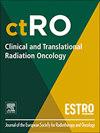Overexpression of JAML in colorectal cancer cells predicts higher radiosensitivity by inactivating ATR pathway
IF 2.7
3区 医学
Q3 ONCOLOGY
引用次数: 0
Abstract
Background
Junctional adhesion molecule–like protein (JAML) is highly expressed in cancer tissues of patients with colorectal cancer (CRC) and promotes cancer proliferation. However, the relationship between JAML expression and radiosensitivity of CRC remains unclear.
Methods
Stable CRC cell lines with knocked down or overexpressed JAML were used to evaluate the effects of irradiation on cell viability and cell proliferation using Cell Counting Kit-8 (CCK8) and cell clone formation assay, respectively. Cellular immunofluorescence, flow cytometry, and western blotting were used to determine the mechanism. Tumor-bearing nude mouse models were established to verify the relationships between the expression of JAML and the radiosensitivity of CRC.
Results
The results of CCK8 and cell clone formation assay showed that the viability and proliferation of CRC cells with JAML overexpression were significantly inhibited after exposure to irradiation compared with those of CRC cells with low expression of JAML. DNA damage and cell apoptosis were significantly increased in the JAML-overexpression group compared with the JAML-low-expression group after exposure to irradiation. The phosphorylation of the ataxia telangiectasia and Rad3-related protein (ATR)-checkpoint kinase 1 (CHK1)-mediated DNA damage repair pathway was inhibited in the JAML-overexpression group compared with the JAML-low-expression CRC cells after irradiation. Similar results were observed in CRC xenografts in vivo.
Conclusions
CRC cells with JAML overexpression are more sensitive to radiotherapy of X-rays because of the decreased phosphorylation of the ATR-CHK1-mediated DNA damage repair pathway. The expression of JAML in CRC cells could be used as a predictive biomarker of radiosensitivity in patients with CRC.
结直肠癌细胞中JAML的过表达可通过灭活ATR通路预测更高的放射敏感性
结直肠癌(CRC)患者的癌组织中高表达的连接粘附分子样蛋白(JAML)可促进肿瘤的增殖。然而,JAML表达与CRC放射敏感性之间的关系尚不清楚。方法采用细胞计数试剂盒-8 (cell Counting Kit-8, CCK8)和细胞克隆形成实验,分别评价辐照对JAML敲低或过表达的CRC稳定细胞系细胞活力和细胞增殖的影响。细胞免疫荧光、流式细胞术、western blotting检测其作用机制。建立荷瘤裸鼠模型,验证JAML表达与CRC放射敏感性之间的关系。结果CCK8和细胞克隆形成实验结果显示,与JAML低表达的CRC细胞相比,JAML过表达的CRC细胞的生存能力和增殖能力受到了明显的抑制。暴露后,与低表达组相比,过表达组的DNA损伤和细胞凋亡明显增加。与低表达jaml的CRC细胞相比,jaml -过表达组在辐射后的失调性毛细血管扩张和rad3相关蛋白(ATR)-检查点激酶1 (CHK1)介导的DNA损伤修复途径的磷酸化被抑制。在体内CRC异种移植中也观察到类似的结果。结论JAML过表达的scrc细胞由于atr - chk1介导的DNA损伤修复通路磷酸化降低,对x射线放疗更敏感。JAML在结直肠癌细胞中的表达可作为结直肠癌患者放射敏感性的预测性生物标志物。
本文章由计算机程序翻译,如有差异,请以英文原文为准。
求助全文
约1分钟内获得全文
求助全文
来源期刊

Clinical and Translational Radiation Oncology
Medicine-Radiology, Nuclear Medicine and Imaging
CiteScore
5.30
自引率
3.20%
发文量
114
审稿时长
40 days
 求助内容:
求助内容: 应助结果提醒方式:
应助结果提醒方式:


